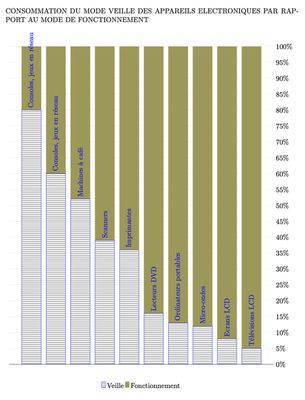How much electricity do appliances placed on standby consume?
Overall, our electrical and electronic appliances consume nearly 3 TWh, or 3% of total electricity consumption in Switzerland every year. This proportion is set to rise… Depending on the appliance, standby mode represents between 5% and 80% of its electricity consumption.
The multitude of computers, televisions, printers, photocopiers, telephones, and other coffee machines that proliferate in our daily lives constantly consume electricity. Paradoxically, given their relatively short periods of active service, they consume the most electricity when they are not in use! Their standby electricity consumption can account for up to 80% of their total energy balance [→ see figure below]. A majority of devices consume even when they are completely switched off, either because they are equipped with a transformer located on the power cable before the on/off switch. or because some functions continue, drawing on the batteries.
Advances in technology have significantly reduced the individual power consumption of these devices in operation. However, although electrical and electronic appliances often consume less today than they did 20 years ago, Swiss households are increasingly owning more and more of them. All in all, the amount of electricity consumed annually by all these devices continues to increase!
Since 2013, most electronic and household appliances sold in Switzerland must consume no more than 1 watt in standby mode and 0.5 watts when switched off. In 2013, this resulted in a saving of 0.3 TWh.
Unfortunately, the effort made by the Confederation is in danger of being wiped out by the proliferation of these appliances and their increasing need for standby mode in order to remain interconnected and to be able to communicate with each other. The International Energy Agency predicts that the electricity consumption of electrical and electronic devices in Europe will increase by 36% between 2010 and 2040, mainly as a result of their standby mode.

References
- 4E Energy Efficient End-use Equipment International Energy Agency (2014)
- 4E Energy Efficient End-use Equipment International Energy Agency (2014). More data, less energy - making network standby more efficient in billions of connected devices. International Energy Agency (IEA).
- Canton de Genève (2019)
- Canton de Genève (2019). LES ECOGESTES A L’ETAT DE GENEVE.
- Canton de Vaud (2019)
- Canton de Vaud (2019). La consommation inutile des appareils électroniques. [Online]. Available at: www.vd.ch/themes/environnement/developpement-durable/dd-au-travail/fiches-dd-info/appareils-electriques/.
- Conseil fédéral (2014)
- Conseil fédéral (2014). Le Conseil fédéral introduit de nouvelles prescriptions pour des appareils électriques économes. [Online]. Available at: www.admin.ch/gov/fr/accueil/documentation/communiques.msg-id-53496.html.
- Office fédéral de l'énergie (OFEN) (2019)
- Office fédéral de l'énergie (OFEN) (2019). Statistique globale de l’énergie 2018. OFEN.
- Sidler (2009)
- Sidler, O. (2009). Connaissance et maîtrise des usages spécifiques de l’électricité dans le secteur résidentiel. Notes techniques-Enertech.